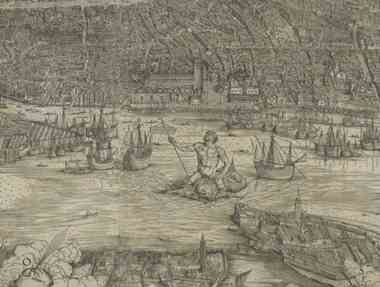Before helicopters, airplanes or hot-air balloons, birds were the envy of humans. Only they saw the world from aloft, soaring high over cities and plains with a perspective mere mortals could only dream of. That's the world in which Jacopo de' Barbari set out to picture Venice from the air. Centuries before satellites and Google maps he climbed the city's bell towers, palace roofs and church domes, sketched what he saw, and then in 1500 produced an enormous map that is one of the wonders of the Renaissance.
 Earlier this month the Minneapolis Institute of Arts bought a copy of Barbari's "View of Venice," a monumental black-and-white image that's more than 9 feet wide and one of only 13 known to exist. For the past 200 years it belonged to the dukes of Rivoli, an aristocratic French family that recently sold it to an English dealer from whom the museum purchased it. The map will go on display in conjunction with the show "Titian and the Golden Age of Venetian Painting," opening Feb. 6.
Earlier this month the Minneapolis Institute of Arts bought a copy of Barbari's "View of Venice," a monumental black-and-white image that's more than 9 feet wide and one of only 13 known to exist. For the past 200 years it belonged to the dukes of Rivoli, an aristocratic French family that recently sold it to an English dealer from whom the museum purchased it. The map will go on display in conjunction with the show "Titian and the Golden Age of Venetian Painting," opening Feb. 6.
A marvel of observation, the map is so vast and detailed that it accurately shows hundreds of building facades, an early Rialto bridge spanning the Grand Canal, Piazza San Marco at the city's heart, and even overturned ships under construction in Venice's famous boatyards.
"It's an artistic and propagandistic tour de force that immediately becomes one of the gems of our collection," said Tom Rassieur, the museum's curator of prints and drawings. "It's a spectacular object because of its sheer scale, the magnificence of its craftsmanship, and the way it brings together the intellectual, scientific and artistic ambitions of the Renaissance."
In 1500 Venice was an independent state and still the dominant sea power in the Mediterranean, although Spain and Portugal were fast closing in on its maritime hegemony. Less than a decade earlier, Columbus' trans-Atlantic voyage tilted the balance of power westward and signaled the start of Venice's long, slow decline. Still rich, but economically threatened, Venice was eager to broadcast its glories as a mercantile, cultural and political hub. For that, Barbari's map was just the ticket.
Sea power in print
Besides the city and nearby islands, the map emphasized maritime power. Huge ships sail its waters, and in the foreground Neptune, god of the sea, rides his dolphin, the city's emblem. At the map's edges, lively personifications of the winds blow from every direction, subtly reinforcing the notion that Venice is the center of the world.
By skillfully altering perspectives, Barbari further amplifies the city's symbolic grandeur. He offers a profile view of the distant Dolomite mountains, reducing them to an undulating ribbon at the map's top, but presents the city itself from the angled bird's-eye vantage that modern visitors experience when approaching by plane. The city unfolds in a dynamic, bustling panorama more reminiscent of an imaginative painting than a navigational map. With a bit of artistic license that doesn't much compromise accuracy, Barbari even gently manipulated the city's outline to accentuate its "dolphin" shape.
Barbari and probably some assistants worked on the project for at least three years. The map was so big it had to be printed from six separate woodblocks on specially made paper that was twice the size of anything then available. The map consists of six sheets of paper, carefully joined into a near-seamless whole. The Minneapolis version is one of the best surviving examples, its lines still crisp and the edges of each sheet unworn. All of the surviving maps are in museums, five in Venice, three in Germany, one each in Britain and France, and two others of lesser quality in Boston and Cleveland.
Best known as a printmaker and engraver, Barbari began his career in Venice but worked in Germany and the Netherlands after 1500 and died around 1515 at an unknown age. His name doesn't appear on the map, but scholars figure he was the creator because his emblem, a caduceus or staff wrapped with snakes, figures prominently in the design. Also, Barbari worked closely with the map's publisher Anton Kolb, a Nuremberg merchant who lived in Venice and persuaded the city's governors to grant him a three-year copyright on the project and permission to sell it for three ducats. That was a huge sum at the time, equal to about two months' salary for a teacher.
"To my knowledge, it's the first image that was ever copyrighted," said Rassieur. "The Venetian senate granted it because they were very aware of the map's value, and the copyright allowed Kolb to recoup his production costs."
When the map was published in 1500, artists were essential to the spread of ideas and the maintenance of state power. Besides producing maps and portraits, they planned everything from fortifications to triumphal pageants and theater productions. Among the giants of the era were Michelangelo, Raphael and Leonardo in northern Italy and Dürer in Germany. Titian, whose rich colors and robust compositions made him the prince of Venetian painters, was a teenager at the time. In such a constellation of talent, Barbari was just a small star, but one whose greatest accomplishment -- his "View of Venice" -- is still awesome.
Source: Star Tribune [December 21, 2010]